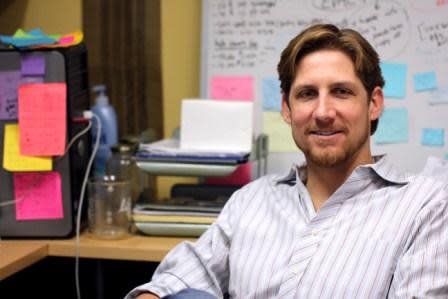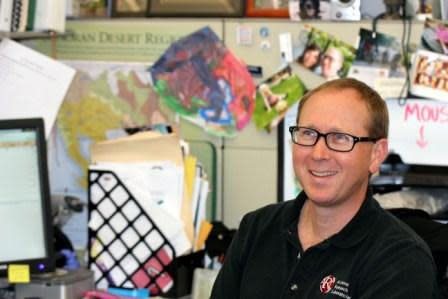Solving the Mysteries of the Human Condition Using Genetic Tools
The University of Arizona Genetics Core (UAGC), located in the Thomas W. Keating Bioresearch Building on the UA campus, is home to rows of rectangular machines that hum busily at all hours of the day and night. These machines, with names like Illumina HISEQ 2000 and Ion Torrent, are the inanimate workhorses of the UAGC, producing hundreds of thousands of pieces of data in a single run. They sequence DNA and RNA, the genetic code and the genetic messages that program the building blocks forming a plant, animal or human. This is Ryan Sprissler's workplace and his intellectual playground.
Sprissler, staff scientist and manager at the UAGC, and a Ph.D. candidate in the UA genetics program, enjoys spreading the word about genetics and the mission of the UAGC. He and his colleagues use genetic tools to explore topics including the story of human migration, and the mysteries of human disease. Sprissler describes a particularly interesting project to which the UAGC contributed--the Genographic Project.
The purpose of the Genographic Project, a collaboration involving the UAGC, National Geographic, IBM and researchers from around the world, was to study patterns of migration based on the genetics of human populations. If a population stays in one place long enough and experiences little or no exchange of genes with other groups, gene sequences common to the group will become fixed. Once fixed, they serve as genetic identifiers or markers for that group.
Geneticists can test for these markers, associate them with locations on the globe and track human migration patterns--sometimes over tens of thousands of years.
During the course of the project, more than 500,000 genetic samples were analyzed in laboratories like the UAGC. The UAGC provided kits for the collection of cheek cells for people who wanted to make personal DNA contributions. The UA completed its obligation to the Genographic Project and Sprissler has a new mission.
"My favorite projects are those that are the most applied," says Sprissler. "They are [the projects] using genetic research to directly affect individuals diagnostically." He seems most fond of an undertaking that may help discover the genetic causes of human neurological disorders.
He tells the story of a young girl with a devastating disease of the nervous system. Doctors could not find a cause, and for years the disorder was misdiagnosed. The girl's physicians thought she might have Rett syndrome or a seizure disorder. Relying on trial and error, they prescribed medication that made little improvement in her condition.
Eventually the girl and her family were connected with UAGC scientists. The UAGC sequenced the girl's individual exome--her genome minus uninformative repetitive sequences. They found the mutation that caused her disorder. Unfortunately there was still no cure for the disease, and the girl eventually died. Understanding the genetic underpinnings of the girl's disorder, however, brought some comfort to her family.
Helping to solve genetic mysteries relating to human disease pushes Sprissler to work in overdrive. His goal is making personalized medicine a reality. Someday, he hopes, people will be able to sequence their genomes quickly and inexpensively in order to find disease susceptibility genes.
Sprissler is an outgoing, but modest man who doesn't like to be the center of attention. His colleagues notice that quality and speak up on his behalf. "Ryan is a good leader, not just because of his skills in molecular biology, but also because he always has a positive attitude, making it fun to work with him," says Taylor Edwards, Assistant Staff Scientist at the UAGC and recent winner of the10th Jarchow Conservation award for his work on desert tortoise conservation genetics.
"This is like watching my mom talk about me," says Sprissler in response to Edwards' comments.
Susan Miller, manager of scientific data analysis with the UA Biocomputing Service, also works with Sprissler. She says, "I love working with Ryan because, for whatever reason, we always end up laughing." She points to doodles Sprissler left on her whiteboard. "There's a part of him that's still a kid."
It's probably that very quality that makes Sprissler a favorite of students who visit the UAGC. On a tour last fall, Sprissler bounded down the hall with a dozen molecular biology students in tow. He explained his favorite projects, and ended the tour by passing out his business cards. "Call me if you're interested in working here," said Sprissler to the students, as they got ready to leave. "Awesome," said a couple of them as they took his card.
Follow Scientific American on Twitter @SciAm and @SciamBlogs. Visit ScientificAmerican.com for the latest in science, health and technology news.
© 2013 ScientificAmerican.com. All rights reserved.





